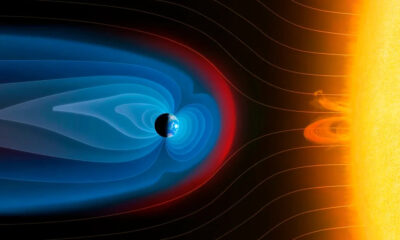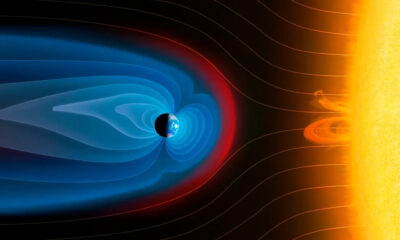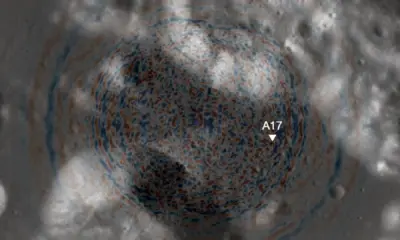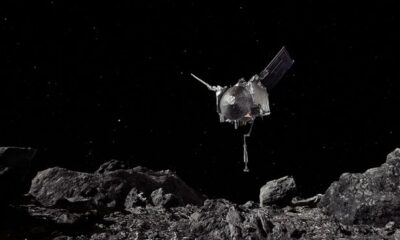Science
SpaceX Successfully Launches Sentinel-6B for Sea Level Monitoring

SpaceX launched the Sentinel-6B satellite on November 17, 2025, marking a significant advancement in global environmental monitoring. This mission, a collaboration between NASA and European partners, aims to provide critical data on long-term changes in sea levels, an essential indicator of climate dynamics.
The Sentinel-6B satellite was successfully launched from Vandenberg Space Force Base in California at 12:21 a.m. EST. It follows the original Sentinel-6 satellite, named after renowned NASA climate researcher Michael Freilich, which was deployed in November 2020. Together, these satellites are part of a billion-dollar initiative designed to enhance our understanding of Earth’s changing climate and its impact on sea levels.
Both Sentinel-6 satellites are equipped with advanced cloud-penetrating radar technology. By measuring how long it takes radar beams to return from the ocean surface approximately 1,340 kilometers (about 830 miles) below, these instruments can gauge sea level changes with an accuracy of around one inch. In addition to tracking sea levels, the satellites also monitor wave heights and wind speeds, providing a comprehensive view of oceanic conditions.
Monitoring Sea Level Changes
The data collected by the Sentinel-6 satellites builds on decades of previous research, offering a continuous record of sea level changes since the early 1990s. This information is crucial in understanding the impact of global warming, primarily attributed to human activities.
While the Sentinel-6B mission is poised to deliver essential data, NASA’s recent communications have notably shifted in language. In a pre-launch briefing, Karen St. Germain, director of NASA’s Earth Science Division, emphasized the practical applications of the satellite’s data without directly mentioning “climate change.” She stated, “Sentinel 6B is the latest in a line of missions stretching over three decades, keeping an uninterrupted watch over our planet’s sea surface height.”
The satellite will support various industries, including navigation, search and rescue, and commercial fishing, while also aiding in flood predictions for coastal infrastructure. St. Germain noted that the data will help mitigate the effects of coastal erosion and saltwater intrusion into freshwater supplies vital for agriculture and municipal use.
Technical Achievements and Future Implications
The successful launch of the Sentinel-6B was executed flawlessly. The Falcon 9 rocket’s first stage powered the vehicle through the lower atmosphere before performing a controlled landing back at the launch site. The upper stage then completed two engine firings before deploying the 1,200-kilogram (2,600-pound) satellite into its designated orbit, which is 1,340 kilometers high and tilted at 66 degrees to the equator. This orbit ensures coverage of 90 percent of the world’s oceans, making it a critical asset for ongoing environmental monitoring.
In addition to sea level measurements, Sentinel-6B will also track temperature and humidity in both the lower atmosphere and stratosphere. This multi-faceted approach allows researchers to analyze atmospheric conditions and their effects on navigation satellite signals.
Craig Donlon, a project scientist with the European Space Agency, encapsulated the urgency of this research, stating, “We see evidence of this dramatic change in many different measurements… but they all point in the same direction: the Earth is warming.”
The Sentinel-6 mission represents a collaboration between NASA, the European Space Agency, the European Organization for the Exploitation of Meteorological Satellites (EUMETSAT), and the National Oceanic and Atmospheric Administration. NASA’s financial commitment to the Sentinel-6 missions totals approximately $500 million, with equal contributions from European partners.
As the world faces the challenges of climate change, the data provided by Sentinel-6B will be pivotal in shaping policies and strategies aimed at safeguarding coastal regions and enhancing public safety. The launch underscores the importance of international cooperation in addressing global environmental challenges.
-

 Technology5 months ago
Technology5 months agoDiscover the Top 10 Calorie Counting Apps of 2025
-

 Health3 months ago
Health3 months agoBella Hadid Shares Health Update After Treatment for Lyme Disease
-

 Technology7 days ago
Technology7 days agoOpenAI to Implement Age Verification for ChatGPT by December 2025
-

 Health3 months ago
Health3 months agoErin Bates Shares Recovery Update Following Sepsis Complications
-

 Technology4 months ago
Technology4 months agoDiscover How to Reverse Image Search Using ChatGPT Effortlessly
-

 Technology3 months ago
Technology3 months agoElectric Moto Influencer Surronster Arrested in Tijuana
-

 Technology1 month ago
Technology1 month agoDiscover 2025’s Top GPUs for Exceptional 4K Gaming Performance
-

 Technology5 months ago
Technology5 months agoMeta Initiates $60B AI Data Center Expansion, Starting in Ohio
-

 Technology5 months ago
Technology5 months agoRecovering a Suspended TikTok Account: A Step-by-Step Guide
-

 Health3 months ago
Health3 months agoAnalysts Project Stronger Growth for Apple’s iPhone 17 Lineup
-

 Health5 months ago
Health5 months agoTested: Rab Firewall Mountain Jacket Survives Harsh Conditions
-

 Lifestyle5 months ago
Lifestyle5 months agoBelton Family Reunites After Daughter Survives Hill Country Floods





















